by Bramber Press, the publishing arm of St Mary’s House & Gardens
To make a purchase, select the appropriate ‘Add to Cart‘ button. Your shopping cart will then appear here. You can then complete your purchase by selecting the ‘Checkout with PayPal‘ button, where you can pay with a credit/debit card or your PayPal account.
PHOENIX OF DRURY LANE – The Sensational Story of London’s Greatest Theatre, by Peter Thorogood
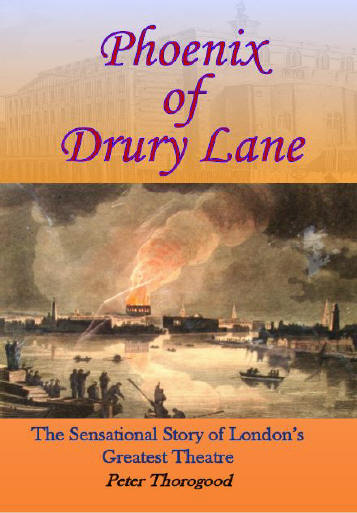
Hard cover with dust jacket, 432 pp (22 colour) ISBN 978-1-905206-04-9 – £25.00
This book is the culmination of half a lifetime of research by the author into the history of the Theatre Royal, Drury Lane, and in particular the various literary figures over the years who have written for this theatre. The pivotal point of the book is the fire of 1809, the rebuilding of the theatre in 1812 and the Addresses submitted for reading at the re-opening.
“No English theatre has had such a rich and chequered history as the Theatre Royal, Drury Lane. From its beginnings in the 17th century, it never ceased to be a place of tears and laughter, of triumphs and disasters, of riot and celebration, of speculation and intrigue, of great tragic acting and sublime comedy. Its vast stage was home to some of the greatest actors of the day.
Two of the most momentous occasions in its turbulent history were the burning down of Henry Holland’s theatre in 1809 and the rebuilding of Benjamin Wyatt’s new theatre in 1812. It was not the first London theatre to end its life in ashes, but like the mythical phoenix to which it was frequently compared, it arose again and again.
In PHOENIX OF DRURY LANE Peter Thorogood gives an account of the desperate search for a suitable Address for the opening of the new theatre in 1812, the fiasco surrounding the 112 rejected addresses, and Lord Holland’s appeal to the reluctant Lord Byron to save the day. The subsequent riotous response to the reciting of the Address at its first performance is one of the most astonishing events in the history of British drama. It brought about the phenomenal success of two brothers, Horace and James Smith, with their composing of Rejected Addresses, or, The Theatrum Poetarum – one of the most extraordinary moments in 19th century publishing history.”
St Mary’s Bramber: A Sussex House and its Gardens by Peter Thorogood

Paperback, 49 pp (black & white illustrations) ISBN 0-9526786-4-0 – £3.50
The definitive guide book to St Mary’s House & Gardens.
St. Mary’s Bramber is a house of mystery and legend. Tales of tunnels beneath the garden and a chapel under the hall are among a number of secrets that past residents have taken with them to the grave. An exact history of this magnificent old house will never be fully established but, through the persistence of local historians and the memories of those who are still alive to reveal some of the hidden past, it has been possible to piece together a fascinating story.
St Mary’s Bramber: A Pictorial Souvenir by Peter Thorogood
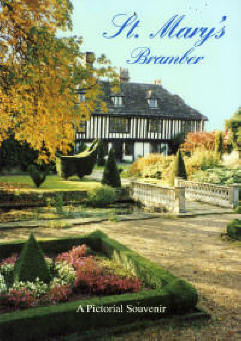
Paperback, 32 pp (full colour illustrations) ISBN 0-9526786-6-7 – £3.50
From the foreword: “When Adam and Eve gave names to all the places of the earth, they marked the beautiful downlands of Sussex for Paradise. This charming fancy, as related by the author Hilaire Belloc, serves to show why so many artists and writers have chosen Sussex as the setting for their paintings and poetry.
How many dedicated recorders of ‘local colour’ there are, dotted about the English countryside on warm summer days, intent on capturing, in oils or watercolours, or in memorable prose and verse the treasured impressions of a lost time. Such poets and painters, some of whose names became synonymous with Sussex ways and byways, have made their own special mark upon the scene, in their varied attempts to discover their own version of Paradise.
Bramber is one of the most painted and photographed of the downland villages, with its imposing Norman castle keep, its ancient cottages of flint and brick, and the magnificent timber-framed pilgrim inn of St. Mary’s, a house of which the writer, Ashley Courtenay, once said that ‘happiness dwells in every room’. This enchanting house and its gardens are enjoyed today by countless visitors who seek something of that old-world charm that remains quintessentially English.”
Thomas Hood: Poems Comic and Serious. Selected, with an introduction and notes, by Peter Thorogood
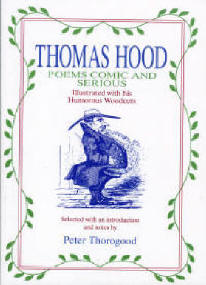
Paperback, 119 pp ISBN 0-9526786-0-8 – £8.00
THOMAS HOOD was a poet of an unusual order of brilliance and invention. He was skilled in almost every form of poetic writing, being equally at home with romantic sonnets and love poems, poignant social poems like The Song of the Shirt, punning ballads, witty parodies and epigrams, sentimental songs and comic ditties for the music hall. He was also skilled in the creation of brilliantly sustained narrative satires and highly original humorous monologues. This representative selection of Hood’s shorter poems and comic verse is illustrated with some of his amusing woodcuts.
PETER THOROGOOD is a leading authority on the life and work of the popular nineteenth century author Thomas Hood, and is the founder of the Thomas Hood Society.
SOUTH OF THE RIVER – A Novel of the Fifties, by Peter Thorogood
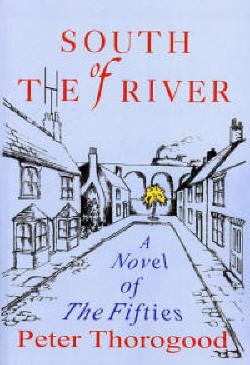
Paperback, 430 pp ISBN 0-9538281-8-2 – £10.00
An entertaining novel about a variety of colourful characters living in a small south London street in the 1950’s – a time of great social change. Laburnum Villas is to be sold for redevelopment within the year and the residents are under threat at the hands of their ambitious landlord, the self-important Councillor Joe Purvis. Things take a turn for the worse with the appearance of the vicious Curly Donoghue, a porter in the Borough Market. Several calamities later, the lives of the residents suffer a change. Whilst on their annual August Bank Holiday coach outing to Brighton, they each experience a ‘moment of truth’ when they are called upon by circumstances beyond their control to reflect on their condition. They return to the Villas to face an uncertain future.
“I couldn’t put it down” – Wendy Cairns
IN THESE PLACES …. AT THESE TIMES: Selected Poems 1950-1975, by Peter Thorogood
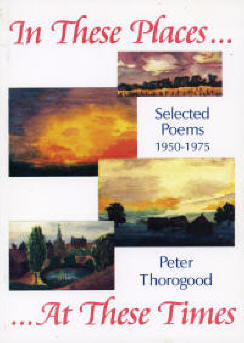
Paperback, 84 pp ISBN 0 9526786 1 6 – £7.50
This is a representative selection of Peter Thorogood’s poetry which covers the first thirty years of his life. His themes range from childhood on the family farm in Essex, with its treasured memories of harvest-time and seaside holidays, to the wider world of travel, going where life and duty took him.
This volume, illustrated with Peter Thorogood’s watercolours, include a number of his humorous verses and pen-and-ink sketches.
“Peter Thorogood is an accomplished poet who expresses himself with excellent lyrical qualities” – Estaban Pijals, Survey of Modern English Poetry, Madrid 1974
THE COMPLETE COMIC AND CURIOUS VERSE of Peter Thorogood
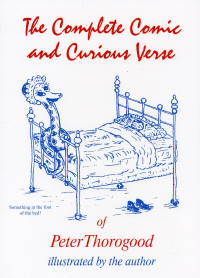
Paperback, 162 pp ISBN 0-9538281-2-3 – £10.00
Peter Thorogood began writing comic verse in the 1950’s. Some years later, he sent a batch of his poems to his bank manager, accompanied by an urgent request for an overdraft facility. The reply came in the form of a letter in verse, surely the only example of the genre by a bank manager to his customer! The result was a volume entitled A Sent-to-Coventry Carol: Verses about Men, Women and Other Beasts, published by the Autolycus Press in 1971. Following his series of readings in and around London in the ’60s and ’70s, a number of Peter’s poems have become part of the poetry reader’s repertoire. This new enlarged edition includes previously unpublished verses such as The Ballad of the Querulous Quail, The Income Tax Inspector and The Alphabet Poem, and over eighty pen-and-ink sketches by the author.
“Many excellent qualities of rollicking humour and visual delight.” Sir Harold Acton
PORTRAIT OF VILLAGE LIFE – Beeding, Bramber and Botolphs in Sussex, by Keith Nethercoate-Bryant, ed Peter Thorogood
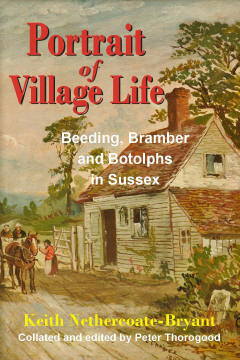
Paperback, 360 pp ISBN 978-1-905206-03-2 – £12.50
Over one thousand years of history recounted through the life and times of three Sussex villages. The book contains a unique collection of more than 200 miniature essays, originally published in the parish monthly magazine The Villager (1983-2003).
Peter Thorogood’s restoration of the 600-year old St. Mary’s House, Bramber, led him explore more widely the history of his adopted village of Bramber. Keith Nethercoate-Bryant’s articles were the perfect beginning of a fascinating historical journey. Peter has once more brought to life the writings of a dedicated, highly respected local historian.
Peter introduces Keith in his introductory biographical sketch ‘Keith Nethercoate-Bryant as I Know Him‘.
With over 130 black-and-white illustrations, mainly from local history archives, and a comprehensive index, Portrait of Village Life gives a vivid picture of a vibrant community and the people who made it.
RETURN TO SPLENDOUR – The Saving of a Country House, compiled by Tony Ketteman
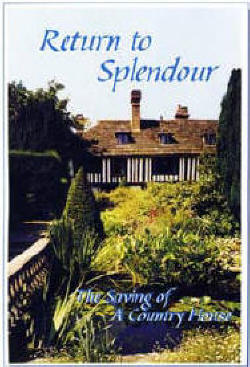
Large format (A4) paperback, 20 pp ISBN 1-905206-01-1 – £5.75
A fascinating account of the restoration of St. Mary’s House and Gardens over twenty years by Peter Thorogood, Roger Linton and their stalwart band of volunteers. Illustrated with seventy full colour photographs.
COULD I HEAR THAT AGAIN, PLEASE – Views and Reviews of a Well-tuned Listener! by Peter Thorogood

Paperback, 364 pp ISBN 1-905206-02-X – £10.00
A fascinating collection of some 250 short reviews of radio broadcasts made during the late 1960s, when Peter Thorogood was Critic for ‘The Spoken Word’ column of the popular BBC periodical, The Listener. The articles cover a wide range of subjects, including art, antique-collecting, books and authors, gardens and the countryside, crime, entertainment, history, music and myth, poets and poetry, the pop scene, poverty and population, revolution and revolt, sport, technology, and travel.
We learn about a sensational scandal involving Mr. Gladstone, George Bernard Shaw’s nom de plume and the wit of Queen Victoria. We track down the elusive Frank Richards, author of the ‘Billy Bunter’ stories; and we discover if there really are fairies at the bottom of our gardens. We can, through Peter Thorogood’s often graphic reviews of these varied broadcasts, ‘hear’ again Sir Paul Dukes’ descriptions of life in Russia during the Revolution, an assessment of Marshall McLuhan and the ‘global village’, and travel the world with actor and wit Peter Ustinov.
The index alone lists over 500 names of broadcasters, presenters, producers, celebrities, literary and historical figures. Illustrated with over eighty portraits and some fifty drawings capturing the essence of broadcasting in the 1960s.
MEASURES OF GENIUS – The Scientists who gave their Name to Units of Measure, by Alan Durden
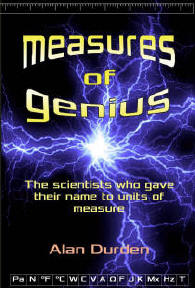
Paperback, 490 pp ISBN 978-1-905206-15-5 – £12.00
Familiar terms such as watt, volt, amp and hertz, are used in everyday language. They honour the work of great scientists, but who are these people? What did they do? Why was their work important? Most people have heard of James Watt, and associate him with the steam engine, but how many know anything about Alessandro Volta, André-Marie Ampère or Heinrich Hertz?
MEASURES OF GENIUS answers these questions and more by providing a fascinating insight into the life and work of the scientists who had units of measure named after them. Taking each scientist in chronological order, the book traces some of the key developments in physical science – astronomy, electricity and heat – during the 17th, 18th and 19th centuries. It also shows how those units form a coherent system of measurements – the metric system (SI) – which has been developed over the last two centuries.
A highly readable and comprehensive account of the lives and work of fourteen scientists who, between them, helped shape the world we live in. It is the story of the quest for understanding the forces that bind the universe together and how that understanding has changed all our lives.
“Wow, what a book! Its 450 pages make fascinating reading and I found it hard to put it down. It gave me an insight into the lives of more than a dozen of the great scientists whose names are now in household use – such as Volta, Watt and Celsius. Mind blowing in many respects – yet the book is written in a very understandable and readable way.“ John Hicks
